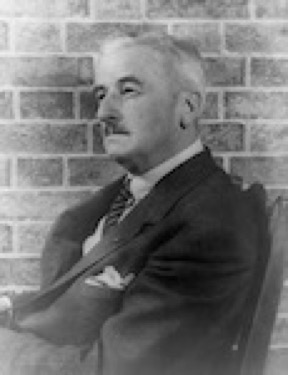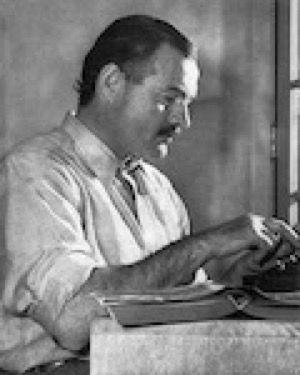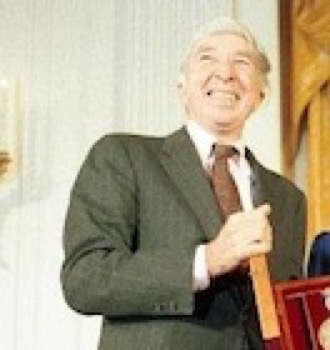Pulitzer Prize
Literary Critique - Separating
September/07/2016 05:40 PM Filed: Literary Critiques

Photo Credit: Dennis Kan
(Wikimedia Commons)
Defining Marriage in Modern Society
John Updike’s “Separating” is the story of a stereotypical family torn apart by a couple’s decision to part company after many years of marriage. Published in 1975, Updike approaches divorce with the nonchalance of the decade, but beneath his laid-back delivery is subtle condemnation.
It’s not clear which party is at fault even though Richard, the protagonist, is seeing another woman. Joan, his wife, is concerned about the children, but no longer particularly worried about her spouse moving out. They appear to want an open marriage more than they want to disrupt the family.
The narrative is told from Richard’s viewpoint: “His wife slept as if slain beside him.”
He may blame Joan’s waning passion for their breakup, but his disturbed, neurotic behavior manifests itself in any situation with his children when he is expected to announce his desire to leave. Though his wife’s viewpoint is nonexistent, her “sleeping” presence in the background can be felt as the catalyst, implying that Joan chose to end her marriage long before Richard decided to have sex elsewhere. Other than fatigue, the reason is not disclosed.
Updike is poking fun at holy matrimony as well as the concept of religious sacrament. Embedded in his plot is an important reminder to uphold the contemporary legal definition. Marriage is a domestic partnership, not an archaic ritual.
Literary Critique - Looking for Mr. Green
September/02/2016 04:13 PM Filed: Literary Critiques

Photo Credit: Keith Botsford
(Wikimedia Commons)
The Quest for Identity
Published in 1951, Saul Bellow’s “Looking for Mr. Green” is the story of George Grebe, a government worker, and his quest for an elusive Mr. Green. Grebe delivers relief checks to homebound people in need. Set in inner-city Chicago, Bellow portrays a community struggling with poverty.
Mr. Green is a symbol of the downtrodden man with no real identity. No one knows him, and no one cares. Throughout the narrative, Grebe searches for a person who may not even exist. Every clue leads to nothing. Every lead takes him nowhere.
Bellow writes, “Why is consent given to misery? And why so painfully ugly?”
Though benevolent society tries to help the poor, attempts often fail due to interference. Before this money will reach the mysterious Mr. Green’s hands, numerous people will try to protect him from the law, or what can be perceived as unwanted government intervention. This may be Bellow’s message.
Literary Critique - Barn Burning
July/13/2016 03:36 PM Filed: Literary Critiques

Photo Credit: Carl Van Vechten
(Wikimedia Commons)
William Faulkner and Class Consciousness
Faulkner’s portrayal of a boy torn between loyalty to his criminal father and need to protect the community is symbolic of the South’s slow progression to social justice. Like a child craving parental approval, the semi-reconstructed former Confederacy often sought the acclaim of its steadfast peers rather than make changes for the overall good of the United States.
In his 1939 story, “Barn Burning,” Faulkner named the young character after a fictional plantation owner, an educated Southern gentleman. With only Confederate interests at heart, this member of the country gentry was a hero only to his comrades.
The Union made significant attempts to control violence spurred by class differences and political power struggles, yet awareness of inequality determined status in every walk of life. Faulkner, a Nobel Prize winner, spotlighted the sad reality that the Civil War was not over. The impact of this bloody conflict disrupted the nation and placed all Americans on the defensive.
Faulkner writes, “He was a little stiff, but walking would cure that too as it would the cold, and soon there would be the sun. He went on down the hill, toward the dark woods within which the liquid silver voices of the birds called unceasing—the rapid and urgent beating of the urgent and quiring heart of the late spring night. He did not look back.”
Class consciousness is at the heart of this plot, recognition of what it is, and condemnation for what it accomplishes. In the last paragraph, Faulkner compares the sun to justice, the dark woods to slavery, and the silver voices of the birds to the emerging voices of freedom.
Literary Critique - A Jury of Her Peers
July/05/2016 03:29 PM Filed: Literary Critiques

Photo Credit: New York Public Library
(Wikimedia Commons)
Authoritarian Marriage and Early Feminism
Susan Glaspell’s 1917 story, “A Jury of Her Peers,” depicts two feminists choosing to keep evidence hidden after a neighbor hangs her abusive husband. A search of her home leads to suspicion, yet proof of Mrs. Wright’s guilt cannot be found until wives of the investigators discover a treasured canary strangled by Mr. Wright. The demure Mrs. Wright is described as lacking in vitality and life, her spouse, intolerant and controlling.
One observer relates her impression of the man to the sheriff’s wife. “No, Wright wouldn’t like the bird—a thing that sang. She used to sing. He killed that too.”
Glaspell writes of a quiet, unassuming woman who turns into a criminal, erupting like a volcano in an act of violence after years of mistreatment. This author views marriage with sardonic contempt. Glaspell asserts her outrage through her characters and portrays the investigators as dictatorial, belittling women’s interests and activities.
This plot does not resolve the problem in question, but has definite finality. The investigators’ wives hide the dead canary, evidence that could prove Mrs. Wright’s motivation. These women are this suspect’s only jury.
Literary Critique - Why I Live at the P.O.
June/27/2016 03:49 PM Filed: Literary Critiques

Photo Credit: Unknown
(Goodreads)
Eudora Welty and the Dysfunctional Family
Welty portrays a dysfunctional Southern American family in “Why I Live at the P.O.,” reminiscent of the troubled, grating regionalism present in the work of William Faulkner. Published in 1941, this story contains a toned down version of the dialect Faulkner favored to convey a character’s background and education.
With a conversational, first person delivery, the protagonist shares the embarrassing details of her life, but cannot be classified as an antihero. Her family argues, each petty problem worse than the last. The bickering is obnoxious. A harsh cacophony of words indicates a power struggle is taking place, sibling rivalry the catalyst.
As this clash intensifies, she determines she’ll be safer and happier living at the post office, her place of employment. The narrator’s personality is a result of her upbringing in a stressful environment. None of these characters have matured emotionally, and even her older relatives exhibit childish dispositions.
Welty’s candid tale touches on serious domestic strife, yet entertains like a confession magazine piece.
Literary Critique - The Grave
June/20/2016 05:37 PM Filed: Literary Critiques

Photo Credit: Unknown
(Wikipedia)
A Symbol of Life
Published in 1944, “The Grave” by Katherine Anne Porter is a story about a brother and sister venturing into an opened family cemetery after remains have been transferred to a new plot. As the children climb into the empty pits, they discover themselves and pieces of jewelry left behind. Although the subject seems morbid, guided by curiosity and fueled by fear, the message leaves the reader with the feeling that a psychological resolution has taken place.
The siblings swap a gold ring and a silver dove, each finding the other treasure more appealing than the one retrieved. Nine-year-old Miranda takes the ring, and twelve-year-old Paul takes the dove.
Significant is the scene that follows when Paul shoots a pregnant rabbit after receiving the trinket from his sister. On slicing the rabbit open, they find the animal’s dead babies. This has a powerful impact on Miranda. At that moment she recognizes her own ability to conceive, and the human being’s ability to extinguish life. The children choose to bury the carcass with the kits wrapped in her skin.
Memories of her family’s grave will always be linked to the symbol of peace Miranda gave Paul and the mother rabbit. This is a revelation, associated with the scent and sight of the hole in the ground, and the rabbit’s unborn offspring. This childhood experience has left Miranda with a promise of renewal and life.
Literary Critique - The Chrysanthemums
June/01/2016 09:00 AM Filed: Literary Critiques

Photo Credit: Nobel Foundation
(Wikimedia Commons)
John Steinbeck and Overt Symbolism
In Steinbeck’s 1937 story, “The Chrysanthemums,” powerful symbolic imagery forms an underlying message. This Nobel Prize winner wrote to entertain and succeeded in creating the extraordinary.
The chrysanthemums are a symbol of a woman’s dormant sexuality. When a handyman stops by her home looking for work, Elisa’s attraction is apparent as she takes an unusual interest in his skills. She does not offer him a job immediately, but they talk about her flower garden. He likes her mums, and she gives him a bouquet.
Steinbeck reveals a hindered woman trapped in a male-dominated society. “Kneeling there, her hand went out toward his legs in the greasy black trousers. Her hesitant fingers almost touched the cloth. Then her hand dropped to the ground.”
Suggestive and competitive, Elisa’s need for equal status with this virile stranger emerges. She’s dissatisfied with traditional marriage and craves activities designated only for men. Later she notices he has abandoned her chrysanthemums in the road. This may appear to be the action of a rude, ungrateful lowlife, but in Steinbeck’s story the action symbolizes rejection and refusal to allow the woman to participate in a man’s exciting world.
In the end, Elisa resigns herself to a substandard, restricted existence and expresses desire to engage in the once forbidden activity that sheltered wives are allowed. She turns to her husband and says, “It will be enough if we can have wine. It will be plenty.”
Steinbeck’s overt symbolism captures the essence of women in a difficult state of transition as they emerged from the flamboyant, free-spirited 1920s and plummeted into the somber, Depression-ruined 1930s. His depiction of a humiliated rural woman makes a stronger impression than a history textbook.
Literary Critique - Hills Like White Elephants
May/26/2016 12:05 PM Filed: Literary Critiques

Photo Credit: Lloyd Arnold
(Wikimedia Commons)
Ernest Hemingway and Understatement
Understatement is characteristic of Hemingway. With a background in journalism, he wrote in a tight, distinctive style. His sentences are concise. His descriptions are straightforward. His dialogue is a rapid, back-and-forth delivery typical of real life.
Even when a story shows ambiguity, as seen in “Hills Like White Elephants,” a conclusion may be found in subtle narrative statements or pieces of dialogue. In a serious, though casual manner, a man is discussing abortion with his laid-back, pregnant girlfriend. He doesn’t want to push the procedure if she doesn’t want to do it. At the heart of this conversation is fear of losing freedom, as well as dread of taking responsibility for an unborn child.
The woman drinks through the scene in a Spanish cafe, and although it sounds as though both have agreed to abortion, the end hints at a different decision. “I feel fine,” she said. “There’s nothing wrong with me. I feel fine.”
Published in 1927, this frank discussion of a woman’s right to terminate a pregnancy was not typical of the decade of Prohibition and flappers. Racy feminists asserted their independence by drinking, smoking, and engaging in sex, but abortion was taboo. Hemingway’s portrayal of this woman is far from trite, even as he depicts her shrugging the matter off.
Or maybe she hasn’t. Her last statement indicates something is resolved in her mind. Asserting there’s nothing wrong could mean she has decided not to intervene, meaning no abortion. Perhaps Hemingway left his story subject to interpretation. Everyone will see a different conclusion, not a lack of resolution.
Literary Critique - A&P
May/04/2016 03:15 PM Filed: Literary Critiques

Photo Credit: George Bush Presidential Library
(Wikimedia Commons)
John Updike and the Emerging Feminist
Published in 1962, Updike’s “A&P” depicts a young grocery store clerk working during a decade when women asserted their independence by flaunting sexuality. Written in the first person, this is Sammy’s description of the events that led to his choice to quit his job in defense of a girl’s right to walk into the store underdressed.
Sammy sees all women as sexual creatures and analyzes their qualities as he works. Queenie captures his attention and sympathy when the manager reprimands her for shopping in her two-piece swimming suit.
It is Sammy’s attraction to Queenie that leads to his act of defiance. His view of her as a member of the opposite sex is typical, his reaction to her atypical. The only difference is personal, a subjective response to her body. Other women have not attracted him to the point where he would defend them in any confrontation.
Shortly after he quits and lays down his apron, Sammy looks for Queenie and her friends outside. Although he anticipates her departure, his desire to find her indicates his motivation. At the moment he makes his impulsive decision, his plan thereafter is apparent.
Sammy follows through with his rebellious statement and exits. In the end he regrets his actions and reflects, “…my stomach kind of fell as I felt how hard the world was going to be to me hereafter.”
Although it may seem ridiculous to assert that Updike encouraged emerging feminism by supporting a woman’s right to disrobe, his message in this story does point to his interest in unrestrained self-expression.
Literary Critique - The Magic Barrel
March/26/2016 10:06 PM Filed: Literary Critiques

Photo Credit: John Bragg
(Wikimedia Commons)
The Biblical Concept of Eve and Spiritual Love
In “The Magic Barrel” Bernard Malamud tells the story of Leo Finkle, a lonely bachelor soon to be ordained a rabbi, in his quest for true love. Leo relies on Pinye Salzman, a marriage broker, to assist him. Published in 1954, this piece is an old-fashioned version of the online dating game. Salzman is a klutzy matchmaker, and his attempts at finding a proper mate for Leo fail.
One day Leo comes upon a picture of Salzman’s daughter Stella and decides this is the woman of his dreams. At first Salzman refuses to disclose his relationship to her and will not allow Leo to meet her. In the end, persuasion wins.
This story is a basic boy-meets-girl tale, but on a deeper level Malamud describes an isolated man struggling with his need to meld sexual attraction with spiritual union, portraying a member of the clergy with a normal libido as he seeks the companionship of a woman with sex appeal, rather than the staid, conservative prospects Salzman has offered. He’s searching for his soul mate.
The final scene is significant. Leo and Stella meet on a street corner while her nervous father watches from a distance. Appealing to the rabbi is Stella’s bad girl appearance with purity in her gaze.
Malamud writes, “Stella stood by the lamp post, smoking. She wore white with red shoes, which fitted his expectations.” As she waits “uneasily and shyly,” Leo notices that her eyes are filled with “desperate innocence” and pictures “his own redemption.”
This instinctive attraction goes back to the biblical story of the Garden of Eden in which Eve is depicted as an alluring cross between ingenue and seductress. Malamud applies this mythical concept to a modern relationship.